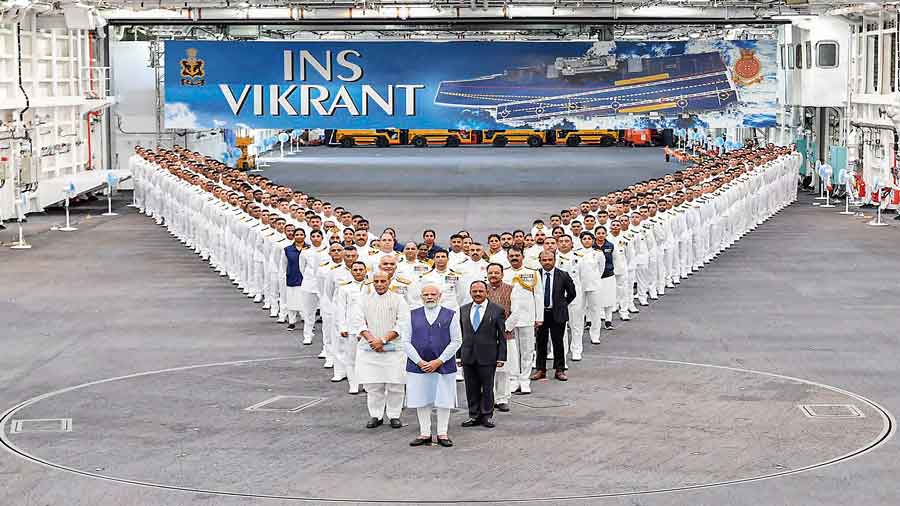Indian Maritime Security Policy Concerning Aircraft Carriers
To meet Indian maritime security challenges, the Indian Navy (IN) inducts aircraft carriers – the latest of which was the 40,000-tonne INS Vikrant (IAC-I). On August 15, 2022, the INS Vikrant was inducted into the Indian Navy. Aircraft carriers are far and beyond the usual attack-minded ship and are essentially mega-ships that aren’t constrained by personnel, aircraft, or logistics.
Indian geostrategic influence in the Indian Ocean region, which is its primary area of interest, will be considerably expanded owing to the induction of an indigenous aircraft carrier. The maritime interests of India, such as an emergency-induced rescue of its non-resident nationals and disaster management and humanitarian relief, will be critically enhanced. The security of island territories is accomplished by patrolling carriers. It is openly known that airstrip-armed islands themselves bear the potential to be aircraft carriers. As far as non-military missions go, the IN will find the mega-ship of much utility in additional sea-based activities such as logistics support. The Indian Navy strategy, entitled “Ensuring Secure Seas – the Indian Maritime Security Strategy (IMSS-2015)”, highlights a few aspects regarding the deployment of aircraft carriers for maritime operations. The IMSS-2015 mandates four roles for the IN: military, diplomatic, constabulary, and benign. Carriers are capable of performing each of these roles definitively and bring their expertise to a number of important domains in the maritime domain as a whole.
To project power on the high seas and subsequently establish sea control over the long term even if limited in geographical reach, the IMSS-2015 states that the IN will look to ensure that its inventory features three Carrier Battle Groups (CBGs) for multidimensional operations. CBGs primarily conduct offensive operations and provide auxiliary ships for other operations. Non-traditional security threats such as natural disasters and sea piracy matter immensely in the context of a maritime strategy. An aircraft carrier is a pivotal instrument meant to combat these and help regain sea control from an adversary through anti-surface, anti-ship, anti-submarine, and naval-air warfare. As far as the technological enterprise of aircraft carriers is concerned, the ability to allow for catapult-assisted launches will help accommodate the naval air wing better.
The IN, now, is unlikely to partake in a medium or high-level land battle due to the hindrances posed by great-power security dilemmas. These dilemmas help sustain a security environment marked by the absence of large-scale war, conflict, or even confrontation in the maritime domain. The exclusive security of the sea lanes of communication (SLOCs) is achieved through destroyer escorts because of insistent non-traditional intimidations. However, an extra aircraft carrier deployed on the western seaboard can lend Indian and foreign-flagged merchant vessels the impeccable services of its air wing for a safe escort through the SLOCs. The entire exercise will critically help advance operational maritime domain awareness (MDA) in a crucial segment of the Indo-Pacific.
The induction and operation of three carriers were envisaged decades ago by the navy’s concept of operations. The common perception within Indian strategic circles is that three aircraft carriers will exert themselves as India’s two-forked maritime-naval arms in each of its seaboards. A third carrier, meanwhile, will be undergoing maintenance or refit. The predecessor of the IMSS-2015, the Indian Maritime Strategy 2009, defined the aircraft carrier as the ‘central platform for projecting power at and from the sea’. Aircraft carriers make themselves present at a navy’s strategic, operational, and tactical levels.

Further, aircraft carriers can serve as powerful coastal attack forces by themselves, thus providing India with a convenient option to deal with geopolitical rivals such as Pakistan. CBGs will also aid the Indian Navy in becoming a provider of net maritime security (IMSS-2015). A more powerful navy equipped with multiple aircraft carriers will also help India preserve its strategic autonomy across conflict-prone chokepoints and waterways. More aircraft carriers also enhance the navy’s ability to undertake humanitarian assistance and disaster relief (HA/DR) and non-combatant evacuation operations (NEO). Naval combat missiles such as the Indo-Russian BRAHMOS will facilitate an effective offensive strategy in the Indian Ocean littorals.
Evolving Indian Maritime Strategy to Achieve Blue Water Dexterity
With the induction of the INS Vikrant, India will likely deploy and operate more CBGs for purposes such as offensive operations, peacekeeping, disaster relief, and logistics support. The blue-water capability of the force will be refined and improvised for new contingency operations. Aircraft carriers offer their value toward empowering the aerial prowess of a navy. India will seek to enable naval air wings to conduct operations at sea by themselves or even alongside frontline attack vessels such as destroyers. Further, they will serve as highly-capable nomadic air bases helping add a geostrategic element to naval presence. Aircraft carriers permit intricate warfare by constituting within themselves the air and sea mechanisms of war. With the INS Vikrant on board, India will have to revisit its maritime doctrine to identify with having taken a step toward the ‘three aircraft carriers’ goal.
Ambivalence to aircraft carriers is prevalent among Indian strategic circles because the maritime-naval utility afforded by these mega-ships can be rationally substituted by strategic island territories in the vicinity. This could have a detrimental impact on India’s maritime-naval strategy that is to do with India’s blue-water evolution in the upcoming years. Yet another concern is that 70% of an aircraft carrier’s resources go into its defence – an aspect likely to be replicated by the INS Vikrant. That being emphasised, India’s evolving maritime-military strategy will be faced with power projection and sea control in the short term across the entirety of the western Indo-Pacific region through the induction of indigenous aircraft carriers. To this end, aircraft carriers serve as a dynamic seagoing instrument of maritime-naval policy and strategic actions for India.
Title image courtesy: Indian Navy
Disclaimer: The views and opinions expressed by the author do not necessarily reflect the views of the Government of India and Defence Research and Studies





